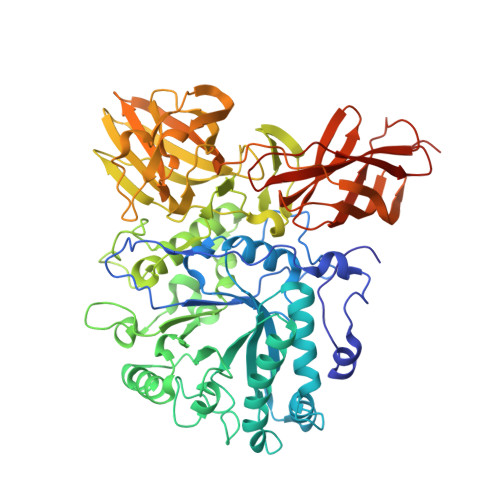Streptococcus Pneumoniae Endohexosaminidase D, Structural and Mechanistic Insight Into Substrate-Assisted Catalysis in Family 85 Glycoside Hydrolases.
Abbott, D.W., Macauley, M.S., Vocadlo, D.J., Boraston, A.B.(2009) J Biol Chem 284: 11676
- PubMed: 19181667
- DOI: https://doi.org/10.1074/jbc.M809663200
- Primary Citation of Related Structures:
2W91, 2W92 - PubMed Abstract:
Endo-beta-d-glucosaminidases from family 85 of glycoside hydrolases (GH85 endohexosaminidases) act to cleave the glycosidic linkage between the two N-acetylglucosamine units that make up the chitobiose core of N-glycans. Endohexosaminidase D (Endo-D), produced by Streptococcus pneumoniae, is believed to contribute to the virulence of this organism by playing a role in the deglycosylation of IgG antibodies. Endohexosaminidases have received significant attention for this reason and, moreover, because they are powerful tools for chemoenzymatic synthesis of proteins having defined glycoforms. Here we describe mechanistic and structural studies of the catalytic domain (SpGH85) of Endo-D that provide compelling support for GH85 enzymes using a catalytic mechanism involving substrate-assisted catalysis. Furthermore, the structure of SpGH85 in complex with the mechanism-based competitive inhibitor NAG-thiazoline (K(d) = 28 microm) provides a coherent rationale for previous mutagenesis studies of Endo-D and other related GH85 enzymes. We also find GH85, GH56, and GH18 enzymes have a similar configuration of catalytic residues. Notably, GH85 enzymes have an asparagine in place of the aspartate residue found in these other families of glycosidases. We propose that this residue, as the imidic acid tautomer, acts analogously to the key catalytic aspartate of GH56 and GH18 enzymes. This topographically conserved arrangement of the asparagine residue and a conserved glutamic acid, coupled with previous kinetic studies, suggests these enzymes may use an unusual proton shuttle to coordinate effective general acid and base catalysis to aid cleavage of the glycosidic bond. These results collectively provide a blueprint that may be used to facilitate protein engineering of these enzymes to improve their function as biocatalysts for synthesizing glycoproteins having defined glycoforms and also may serve as a guide for generating inhibitors of GH85 enzymes.
Organizational Affiliation:
Department of Biochemistry and Microbiology, University of Victoria, Victoria, British Columbia V8W 3P6, Canada.
















